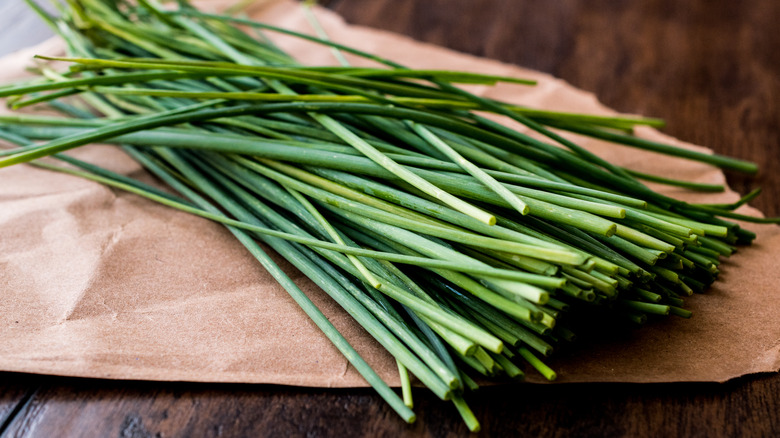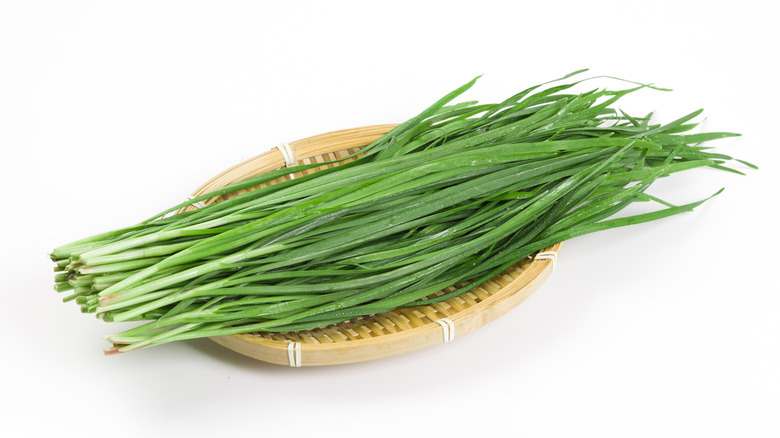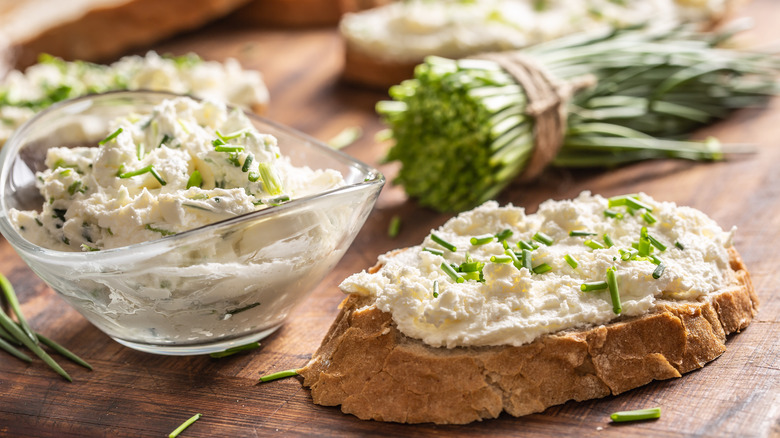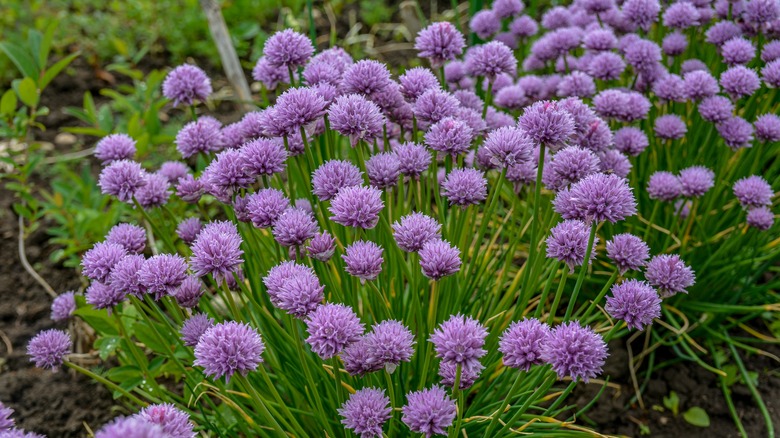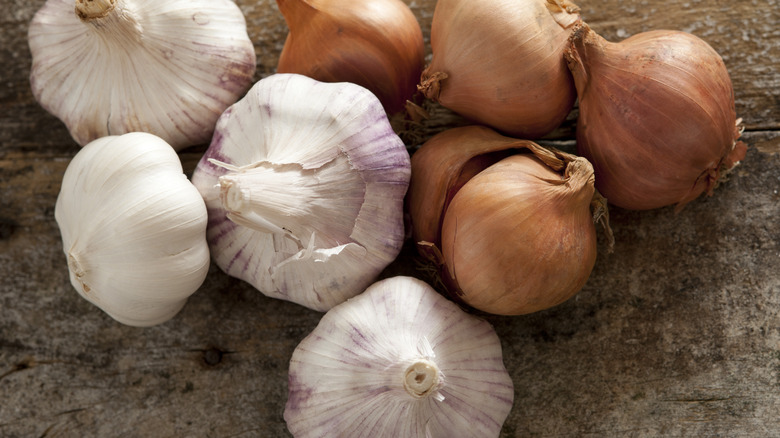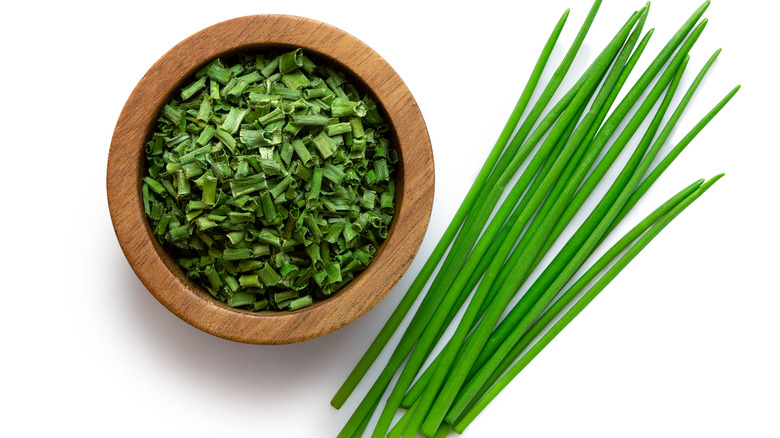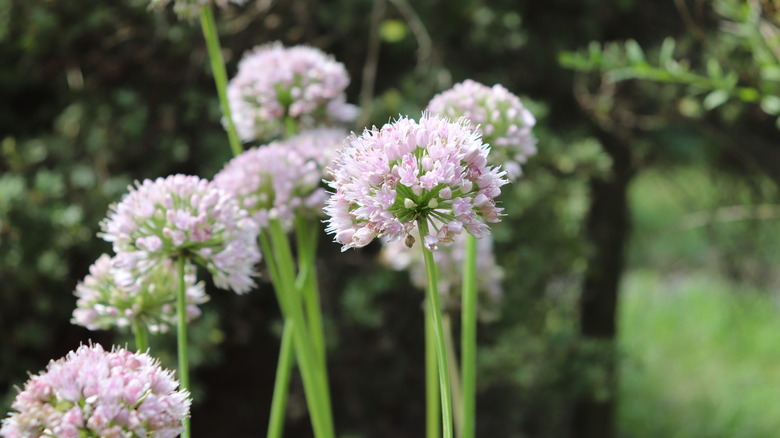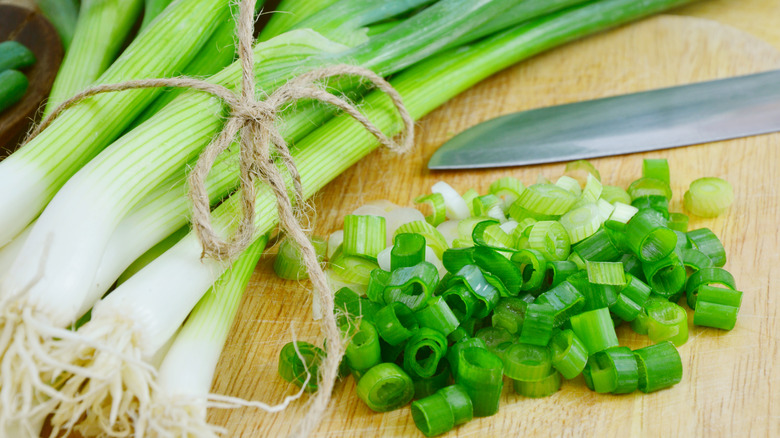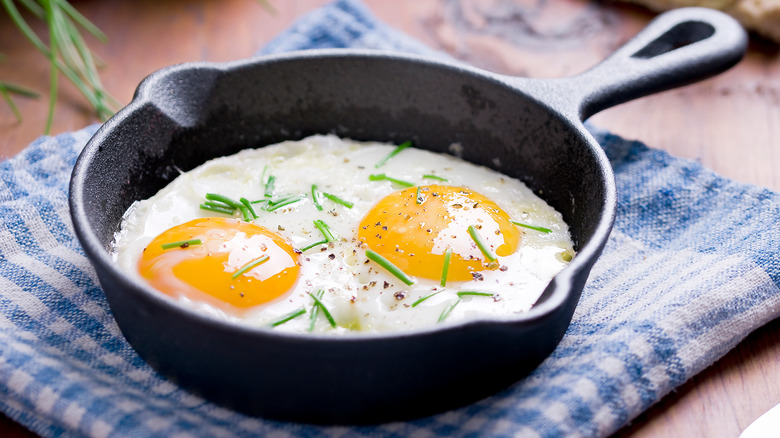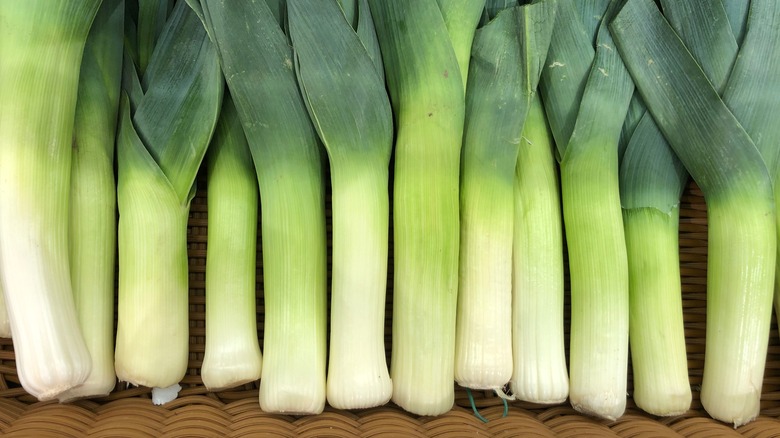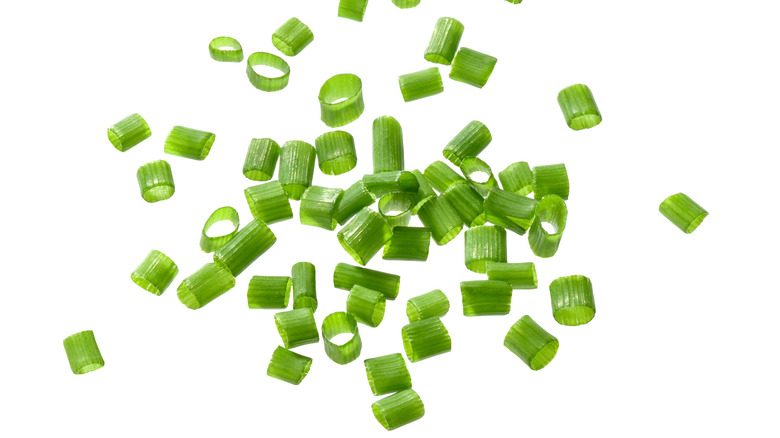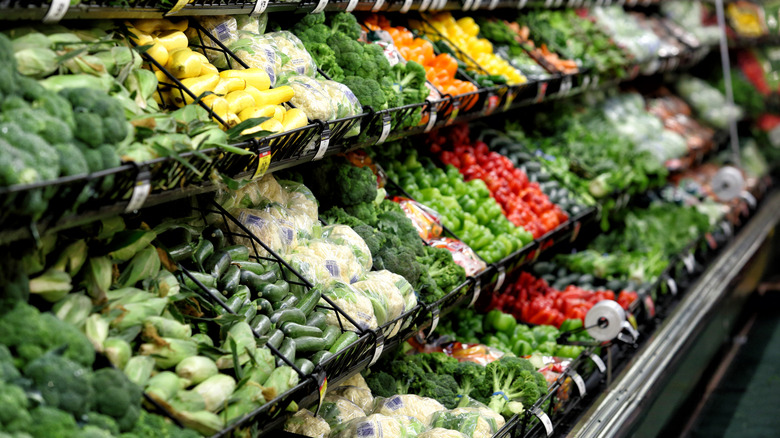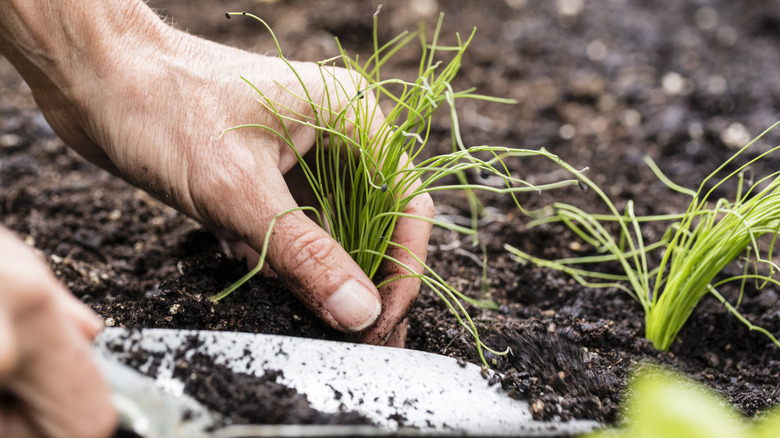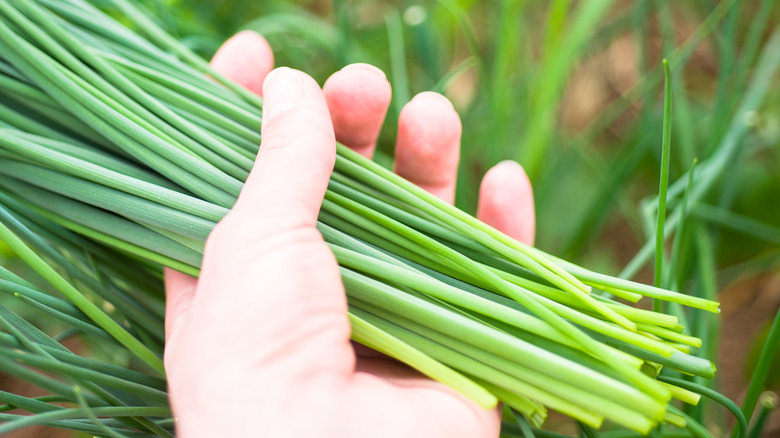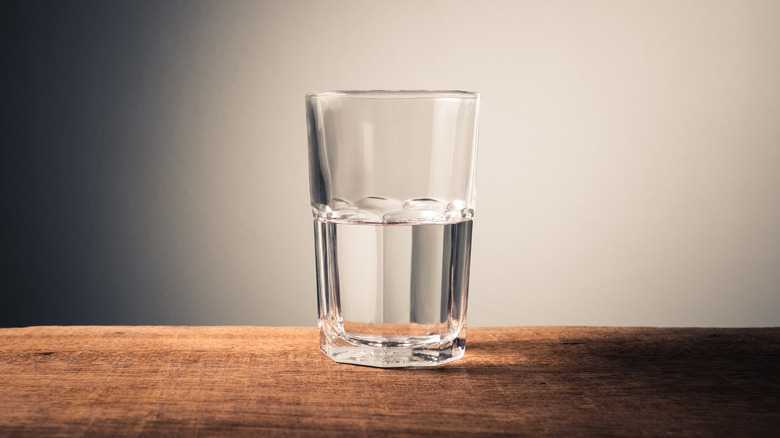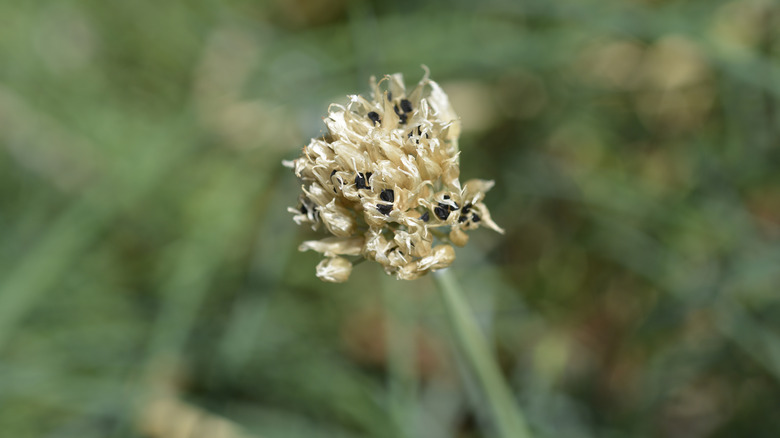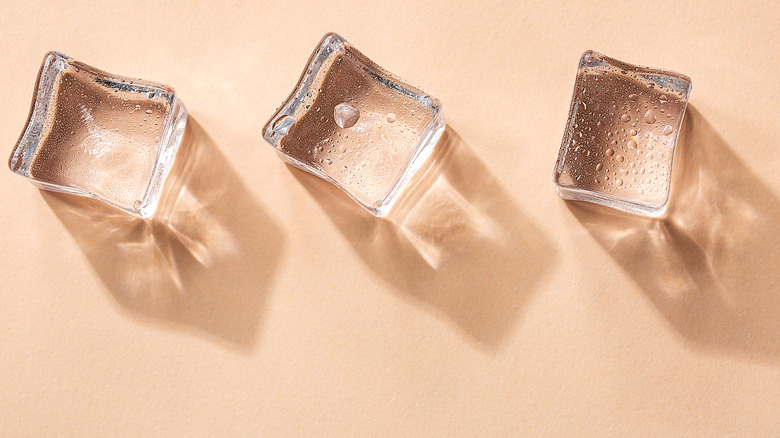What Do Chives Actually Taste Like?
Chives (Allium schoenoprasum) are a common herb usually playing the supporting role in dishes that feature potatoes, soups, and eggs, among others. Known for their bright green color and smooth texture with edges that crisp a bit, chives are natural-born team players in the culinary universe. Typically used to garnish or add color to an otherwise green-less dish, chives need not be slept on. They are a flowering plant with purple blooms in the family known as Amaryllidaceae, which is mostly composed of perennial plants, according to Missouri Botanical Garden.
Onions, leeks, and garlic are also a part of this family with flavor notes that are not terribly far off from each other. It is not difficult to see why. Chives are the perfect companion for the home cook as well as the restaurant chef, whether you're looking to add some herby flavor or sprinkle some life on a dish in need. So what do chives actually taste like? Read on for the answer to that and more.
What are chives?
Chives are a thin, green plant resembling blades of grass from a distance. They grow in fragile, bushy bundles and are perennial, meaning they'll regrow in a garden for more than two years in a row once planted. According to Auguste Escoffier School of Culinary Arts, chives are considered an herb like parsley or basil rather than a vegetable.
Chives are native plants in Europe and Asia, according to Wisconsin Horticulture. It's uncertain whether chives are also native to North America or whether they were brought there. Tubular in shape, its leaves can grow anywhere from 8 to 20 inches in length and boast pops of small purple florets at their tops.
Chives were believed in the Middle Ages to be an ingredient that could keep one young, per Britannica. Though sadly that's not the case, this lively herb still produces essential oils that can be beneficial to your vocal cords.
What part of the chive is edible?
This may come as a surprise to you, but all parts of the chives plant are edible, according to Get Busy Gardening. The bulb, located at the bottom, can be eaten, though the delicate, hollow stems are most commonly used for consumption. The florets are also edible for humans, though it's important you're getting the freshest chives possible for maximum flavor.
Older growth is likely to intertwine with a bunch of freshly sprouted chives, particularly if the plant has been there awhile. It's vital to consume only the bright green (sometimes slightly bluish in color) bulk of this herb and avoid brown or yellowish stalks as they might be dead. Those result in a tough, woody texture that won't be pleasing to the stomach or the taste buds. The seeds of chives can also be consumed in the form of a spice, though it isn't common because of its lack of flavor.
What are the purple tops on chives?
Ever notice that garden chives develop another color that is not green? These fragile purple tops on chives are actually edible flowers, we learn from Garden Betty. Before blossoming, these lavender-colored balls are enclosed and later burst into tiny, individual florets that look like one big flower. You might even notice they resemble red clover flowers.
Why does this flower develop on top of this stringy, green herb? As it goes, chives hit their peak in the springtime. As the summer approaches, chive plants grow scapes (which are simply hollow flower stalks) in an upward fashion. These scapes generate the growth of stiff purple buds, and those turn into the pretty florets you see. Depending on the variety of the chive, the florets might appear white in color or purple, which is the color you will see in the common variety of the herb.
What do common chives taste like?
Here's the question we're all here for: What do chives actually taste like? The flavor profile of this herb is simple, but not one note. Though taste will vary depending on the variety of chives, let's explore the flavor profile of the common chive.
Common chives have an onion-like flavor, but they are still several notches down from the intense flavor a raw onion can pack (via Flavorful Home). This sensation is subtle, and the taste of a fresh chive is reminiscent of toned down garlic, shallots, and leeks, only not as pungent. Though chives that are chopped and eaten raw retain that special bite in flavor, heated chives will lose most of their taste.
As for the florets on chives, their taste is much milder than their bright green bottoms, according to Garden Betty. These florets are effective if trying not to overpower a dish, yet wanting to add a little oomph.
Fresh chives versus dried chives
If you've found yourself enjoying chives the most when they're fresh, it might be that slight pungent flavor giving your taste buds a boost. Chives can also be dried, and both versions serve their own purposes.
If you prefer a stronger flavor, dried chives it is. If growing your own, clipping a fresh bundle and later drying it out is a possibility, according to Flavorful Home. The leaves can also be grounded into a powder and transferred to a glass jar, and there you have it -– a versatile seasoning.
Chives are delicate, and even more so when the herbs are dried. To combat this, dried chives should be added when your dish is nearly finished, we learn from Spices Inc. These thin, absorbent pieces of herb work wonderfully in sauces because they'll rehydrate when they have even slight contact with moisture. Freshly chopped chives will look like tiny rings. These are best used as a garnish, and they are great blended in cheeses and dips and infused in vinegars and oils.
Other varieties of chives
Are you a chives fan? There are five types, including the common chives, according to Spadefoot Nursery. When shopping in North America, you'll mainly come across garlic chives and common chive seeds.
Giant Siberian chives (Allium ledebourianum) aren't native to North America. Although they look like regular common chives, they're much larger. A Giant Siberian chive can grow leaves up to 24 inches long, and the flowers can reach up to three feet tall. With lavender flowers and a bluish-green color in their leaves, these are known for their onion-like taste.
Garlic chives (Allium tuberosum) are also known as Chinese chives and are incorporated into a lot of Chinese cooking. Bearing white flowers instead of purple ones, these are composed of flat green leaves and taste like their name, garlicky. Somewhat similar to garlic chives are Hooker's chives (Allium hookeri), which have much fatter leaves and edible roots that are sometimes pickled, per Spadefoot Nursery.
Siberian garlic chives (Allium nutans) are also known as blue chives. With violet and pink tints in their flowers, Siberian garlic chives are typically grown as an ornament. Though they don't taste like garlic, they may have received their name because of their flat leaves similar to garlic chives.
Chives versus scallions
Let's first clear the air: Green onions and scallions are the same vegetable with an interchangeable name. However, scallions and green onions are not the same as chives, which, if you'll remember, are herbs. Though they can be used similarly in cooking, there are a couple ways they're unique to each other.
Scallions grow in stalks with light to dark green tops and white bulbs at the bottom, according to Auguste Escoffier School of Culinary Arts. Some varieties are onions that haven't matured yet, while others have bulbs, and even more are grown to never have bulbs at all. Chives are harvested differently than scallions in that farmers cut the leaves on chives very close to the ground, essentially giving them a trim. This means they'll grow back within a few weeks.
Chives and scallions, though, can both be used as toppings and are best eaten raw. While scallions are more pungent than chives with a more onion-y flavor, chives are less crunchy in texture and offer more garlicky notes than scallions.
How to cook with chives
When you're looking to add some pizzazz to a dish without causing a distraction in flavor, chives are there to help. Chives are a strong choice if you'd like to add some garlicky onion notes without completely overpowering a dish.
If you are cooking with chives, an important thing to remember is how easily these herbs can bruise. Chopping them before incorporating them into a dish will enhance their natural flavor. To avoid bruising chives, use the sharpest knife in your kitchen to chop as clean as possible, via produce distributor FreshPoint. This also keeps the herb from oxidizing and losing its freshness.
It's best to avoid heating chives. Use low heat if you must, or, if garnishing on a hot meal, top it off at the very end for best-tasting results. Baked potatoes, omelets, and dips are often accompanied with chives as a finishing herb. Soups and seafood also pair well with a chive garnish.
Substitutes for fresh chives
You're craving a bit of fresh chive to amp up your dish, but when you open your fridge, there's none left. Don't fret. This culinary drama doesn't need not stop you from getting that onion-garlic fix. Instead, here are a couple substitutions for when you're out of fresh chives.
Since scallions aren't too far off in taste to this herb, it's undoubtedly the first choice. You'll want to use the greenest part to mimic the flavor of chives, according to A Couple Cooks. One tablespoon of finely chopped scallions is equal to one tablespoon of freshly chopped chives. Leeks are also an option when looking to add a green garnish to a dish, we learn from The Spice House. Remember, though, that it's best to start with a little bit when using an ingredient as a replacement.
If you have dried chives lingering in your cupboard, that's an option too. For every one tablespoon of fresh chives you would have used in your recipe, use one teaspoon of dried chives instead.
Nutritional information about chives
Chives aren't just a pretty topping for your mashed potatoes. This beautiful emerald-colored herb also has health benefits. As a nutrient-dense food, chives have a lot to offer on the nutrient side while at the same time having few calories, according to Medical News Today.
To receive significant enough nutrients from chives, though, you'd have to eat a generous portion, as the herb is typically used as a garnish. One serving is one tablespoon, so you'd have to incorporate it into your diet regularly to benefit from eating it.
Chives contain small amounts of calcium, iron, magnesium, and Vitamin K, all of which are essential for bone health, we learn from the USDA. As an allium, chives may have some cancer-fighting properties, according to WebMD. Chives are also a great ingredient to add to your diet if you're looking to boost your immune system and enhance brain and nervous function as they contain small amounts of folate, choline, and Vitamin A, per WebMD.
Where to buy chives
If you're seeking fresh chives, you'll want to look in the produce area of your grocery store. According to Thrive Cuisine, you'll have the most luck finding fresh chives near the lettuce area. If not there, look for the packaged herbs section because they could also be available there.
If on the lookout for dried chives, scope out the spice aisle. If your grocery store offers spices in bulk, you may also want to check that area out. Popular brands that carry dried chives include Badia, Spice Islands, and McCormick.
If you happen to be at a Walmart, its store locator will tell you exactly where the chives are, whether you're buying organic or regular. Though it isn't likely that Target carries fresh chives, make sure to doublecheck in the spice aisle for dried chives under the Market Pantry or Good & Gather brands. For garlic chives, you might try an Asian market if you don't find them at your local grocery store.
Should you rinse chives before using them?
Like all fresh herbs, chives should always be washed before you eat them. Keep in mind that it's better to rinse them right before you use them to avoid excess moisture while they are refrigerated.
Whether you're buying organic or conventional chives, they've likely been handled by people, according to Cooking Light. Since chives are typically eaten raw, rinsing them to get rid of dirt and residue is a good idea. And because herbs like chives grow low to the ground, they're more likely to get contaminated. Some herbs undergo heating to kill bacteria before being served, though you're more than likely okay omitting this step.
It's best to let chives drip dry after rinsing them. You can also gently pat them with a paper towel, keeping in mind how delicate and susceptible to damage their leaves are. Another option is to delicately dry them in a salad spinner after rinsing.
How chives are grown
You might want to purchase chives at your favorite grocery store if you want to save some time or if they are no longer in season. However, for anyone with a green thumb and access to some soil, growing your own chives is a great and fun option.
Growing chives is not super tedious as well-established plants do a great job taking care of themselves, we learn from Almanac. While they grow well in the spring and fall, they need plenty of water to keep their soil adequately moist. Even though they tolerate drought, you'll get better results when watering them consistently. To add nutrients to the soil, some fertilizers are added in late summer. It's best to divide plants every three to four years to avoid clumping so that you have lush, vibrant bunches of growth. Growing them yourself ensures you'll almost always have some ready to go.
When are chives in season?
So when do these delicate green garden goodies grow best? Chives are best grown in the spring and fall seasons, effectively making them a cool-season crop, according to Almanac. During the summer, this herb is usually inactive and comes back when the weather cools. It is best that you hit up your local grocery store around that time if scouting for the best quality chives.
Due to chives' long seasons for growing, they can often be the first thing harvested in a home garden, according to Get Busy Gardening. Chives can be harvested up until their season is over, in which case their leaves will begin to brown due to the change in weather. The leaves can be cut as soon as they pop up and reach a reasonable height, and they can be cut all the way down to the ground. They will not take too long to grow back.
You can re-grow chives in water
Chives aren't just a school plant-growing science project for kids (though they can be). Yup, you can take chives you've bought at a grocery store and regrow them in water at home when supplies run low. In doing this, you're encouraging sprouts to grow, and eventually, the chives will come back in all their green glory.
Firstly, grab a dish or cup and place a shallow amount of water in it, according to Gardening Know How. You'll need a chive that has a bulb on it, and it should be placed in the water. The roots should be submerged. To avoid mold growth, make sure to dump out the water every few days and replace it with fresh water. You should soon notice green shoots appearing, and you can harvest them by giving them a healthy snip. Let them grow to the height of your desire, though, first.
How can you save chive seeds?
If growing your own chives, you'll want to make sure to take care of your plant's seeds, according to Almanac.
When chives develop flower buds on their tops, this means they're nearly ready to produce seeds, according to a YouTube video by Midwest Gardener. After the flowers bloom, they dry out and produce seeds that are ready to be released. If the flowers are left alone, the seeds will drop, and you might end up with some overcrowding as new chives try to grow too close to your already-existing batch.
How to save these precious seeds? Take a container and gently tip the dried out flowers over it, shaking them carefully. Let the seeds fall into the container. If the flower isn't letting go of its seeds, then let it be. Try again later. You can use these harvested seeds when re-growing a new bundle of chives or if you want to grind them into spice.
How to store chives
Whether you buy chives from the supermarket or harvest your own, there are a couple proper methods to storing them. This will determine their quality.
If you are looking for longevity, go ahead and freeze your chives. They will last for up to six months, according to MasterClass. Drying them will give you up to three years of usage when they're stored at room temperature in a sealed container. If you want them to retain their mild crispness, then in the fridge they go where they will last 10 to 14 days when wrapped in a moist paper towel. You can also leave them out at room temperature if you have a fresh batch you're aiming to use within six days.
You'll also want to wash your chives right before use instead of before storing them because moisture can turn them soggy once they enter the fridge. If choosing to freeze them, you can chop and place them in an ice cube tray with water and later transfer your cubes into a freezer bag. If you're worried your chives might be spoiled, look for signs that include yellow and brown coloring and loss of green. If they are slimy when you touch them or if they smell off, don't use them.
